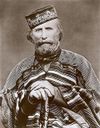A History of Southern Italy
One of the several books I read on our recent trip was Between Salt Water and Holy Water by Tommaso Astarita. It’s a history of southern Italy which unfortunately, was more informative then entertaining reading. It is a description of the many invasions and occupations of this part of Italy and the politics of the area. Both the Romans and the Greeks were interested in the beautiful coasts and fertile ground of the area, but many other cultures also occupied the area. For example, in the 9th century the Arabs occupied Sicily. As a result, modern Mediterranean civilization arose out of Southern Italy and Sicily.
The unification of Italy from separate states started with Giuseppe Garibaldi who led a revolt against existing powers. In 1860 he sailed to Sicily f rom Genoa with a thousand rebel soldiers overcoming resistance. From there he moved to Palermo and Messina driving out the French. On August 20th Garibaldi landed in Calabria and the next day entered Naples, with the French monarchy leaving in advance of his troops. Victor Emmanuel II, was born in Turin and assumed the title King of Italy, the first king of a united Italy. He supported Garibaldi’s "expedition of a thousand" but halted him when he appeared posed to attack Rome which was "Papal States" under French protection. Later Emmanuel was excommunicated for defeating Papal forces in Umbria. Even today Italy is not really totally united in the political and cultural sense of unification. Italians always describe themselves as "from" a particular town, province or area. The attitudes remain provincial even today about areas of Italy. Fierce pride in one’s town or area prevails over an attitude of being Italian as a country.
rom Genoa with a thousand rebel soldiers overcoming resistance. From there he moved to Palermo and Messina driving out the French. On August 20th Garibaldi landed in Calabria and the next day entered Naples, with the French monarchy leaving in advance of his troops. Victor Emmanuel II, was born in Turin and assumed the title King of Italy, the first king of a united Italy. He supported Garibaldi’s "expedition of a thousand" but halted him when he appeared posed to attack Rome which was "Papal States" under French protection. Later Emmanuel was excommunicated for defeating Papal forces in Umbria. Even today Italy is not really totally united in the political and cultural sense of unification. Italians always describe themselves as "from" a particular town, province or area. The attitudes remain provincial even today about areas of Italy. Fierce pride in one’s town or area prevails over an attitude of being Italian as a country.
While in Rome Lita and I visited a park where there is a large statue of Garibaldi’s companion Anita on a horse. She holds a revolver in one hand and cradles a baby in the other to signify she was both a warrior and a mother who fought alongside her Garibaldi in battles. She had met Garibaldi when he had had gone to Brazil to support their revolution for Independence and left her husband to go with him to other causes and fought alongside him on horseback.
I was interested to read that in 1054 the Pope and the patriarch of Constantinople excommunicated each other over a power struggle that resulted in the separation of the Catholic and Orthodox churches.
The history of the area is totally involved with Papal power, foreign occupation and internal fighting. The book indicates that the Normans captured the city of Reggio, where dad was born, in 1059. The book reports that between 1876 and 1914 (the time period dad immigrated to America) approximately 14 million Italians left Italy and one third of these were from Southern Italy. Five million of these went to the United States. Three out of four Italians going to America were from the South. These peasants were destitute and desperate. By 1910 there were about 600,000 Italians living in New York City.
The history of Mount Vesuvius and Mount Etna causing earthquakes and volcanic eruptions was of particular interest because of the stories dad told about a massive earthquake of his childhood and our seeing smoke coming from Mt. Etna while we were on the trip as well as active volcanos. One shoots fire and can be clearly seen in the night time. These volcano’s have a history of causing death and destruction in the South. In 1883 an earthquake killed over two thousand people on the island of Ischia. In 1906 an eruption of Vesuvius killed two hundred people. In 1908 there was an earthquake that destroyed much of Messina and much of Reggio Calabria killing up to a hundred thousand people. In 1915 there was another earthquake in Abruzzo which killed some thirty thousand people. Yet the Southern Italians rebuild their homes and villages on the slope of these mountains.
The history of Southern Italy is very old and complex and the book is very informative about it.
